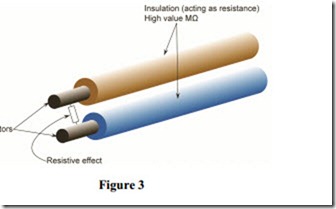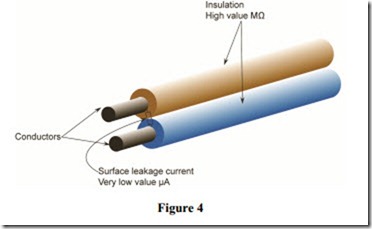Insulation Resistance
Live conductors are separated from each other and from earth by insulation. This insulation ensures that the current flowing between conductors and to earth is kept to an acceptably low level. In simple terms, insulation is perfect, so that its resistance is infinite and there is no current flow through it at all. In practice however, there will always be a very low current, flowing between conductors and to earth. This is known as Leakage Current. This current is made up of three components.
Capacitive Current
The insulation between conductors at different voltages, behaves as the dielectric of a capacitor. The conductors behave as the capacitor plates. When a direct voltage is applied to the conductors, charging current will flow. It will quickly die away as the effective capacitor becomes charged ( usually in much less than one second ). When an alternating voltage is applied, there will be charging and discharging taking place. There will be a continuous flow of alternating current through the insulation.
Conduction Current
The resistance of the insulation is not infinite, so a small current flows through its resistance. If the insulation is damaged ( bruised, cracked or damaged by heat ) this current value will increase.
Surface leakage Current
Where the insulation is removed for connection of conductors and so on, current will flow across the surfaces between the bare conductors. If the surfaces are clean and dry, the value of the leakage current will be very small indeed, but it may become significant in wet and dirty conditions.
Total Leakage Current
The total leakage current is effectively the sum of the capacitive, conduction and surface leakage currents described above. Each current, and hence the total leakage current is affected by factors such as ambient temperature, conductor temperature, humidity and the value of voltage applied.
Total Insulation Resistance
Insulation resistances are all effectively connected in parallel. The total insulation resistance will therefore be lower than that of each individual circuit. In a large electrical installation, the total insulation resistance may be lower than that of a smaller installation.


